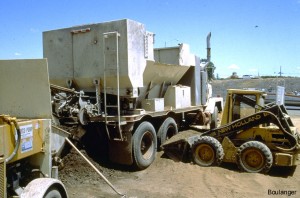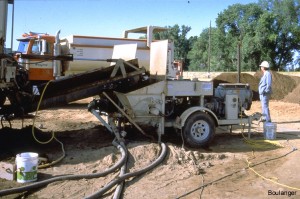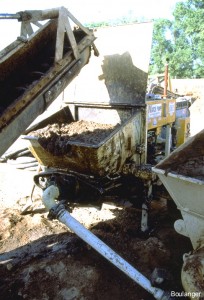Compaction grouting was performed at a site in Sacramento, California, in 1992, to improve the liquefaction resistance of a underlying sand layer. Compaction grout does not permeate a soil, but rather displaces it. The shearing of the surrounding soil as it is displaced by the compaction grout can result in densification if the confining stresses (depth of overburden) are sufficient. See “Compaction grouting – General Information” for more details on the processes involved.

At this site, an air percussion rig was used to advance grout pipes to the desired depth. The driller is making sure the pipes are vertical before starting to drive them.

Silty sand was the main ingredient in the compaction grout. The other components were Portland cement and water

The truck mixes the silty sand, Portland cement, and water (and sometimes other additives on other jobs) together in set proportions. The final grout mixture is delivered from the truck along this screw auger chute.
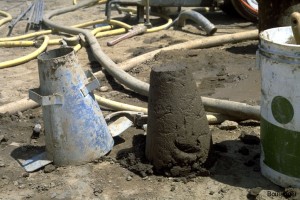
A slump cone test, just like performed on a Portland cement concrete mix, is usually performed on bulk samples of the grout mix. This thick grout mixture will not permeate the pores of the soil that it is injected into, but will rather displace it.
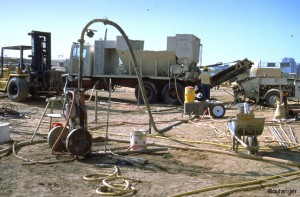
Grout is pumped from the grout pump (in the background) through a hose that connects to the top of a preinstalled grout pipe (left-front of photo). The grout pipe is connected to a hydraulic jack that progressively pulls the pipe out of the ground. Grouting is periodically stopped to remove a segment of the grout pipe as necessary. The grout pressure is measured by a gage near the top of the grout pipe, with pressures of 50 to 600 psi being common.

Close up of the hydraulic jack gripping onto the grout pipe. The pipe is usually pulled in increments of one, two, or three feet. This is called the “bottom-up” method because grouting begins at the bottom of the hole and progresses upwards. Measurements of ground surface heave, grouting pressure, and grout injection volumes are used to determine when the grout pipe should be further withdrawn

